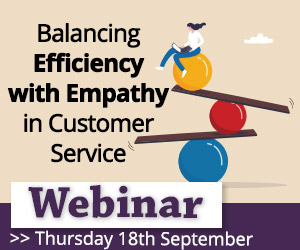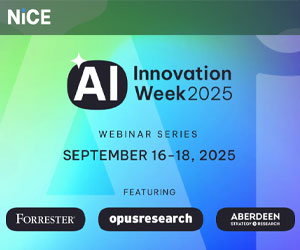Jonathan Mckenzie at 8×8 tells us everything we need to know about how generative AI and conversational AI can make all the difference in delivering an outstanding customer experience (CX) and employee experience (EX).
How Does AI Work to Deliver Outstanding CX?
With all the noise there has been around AI, some of it not exactly positive, let’s not underestimate its value.
Among its many business applications, AI is hugely instrumental in driving growth and improving the experience of customers.
Companies using AI to boost performance attribute 30% of their total revenue to their AI solutions, according to Accenture.
At the start of 2024, 48% of organizations across all industries were using some form of AI in customer interactions, according to research by Metrigy. In retail, this figure is 58%.
So, let’s take a fresh look at the heavy lifting AI does to help customer-facing organizations and their customer engagement decision-makers deliver outstanding CX.
What Has AI Ever Done For Customer Experience?
First and foremost, AI is a powerful and invaluable tool for CX. It provides insight and learning from the vast amount of data it can process.
AI has transformed customer experience by enabling personalized recommendations, improving customer service with chatbots and voice assistants, providing deep customer insights through data analytics and predictive modeling, automating routine tasks, enhancing user interactions via natural language processing, analyzing customer sentiment and feedback, and facilitating continuous improvement through real-time feedback and A/B testing.
The two main types of AI spoken about with regards to the contact centre and customer experience are conversational AI and generative AI.
Let’s Talk Conversational AI
Conversational AI includes exciting technologies like chatbots and virtual assistants that use natural language processing and machine learning to simulate human conversation.
It enables automated, real-time interactions, enhancing customer service, support, and engagement by understanding and responding to text or voice inputs.
Conversational AI is used to create instant, effortless, and engaging self-service experiences for customers through chatbots and intelligent virtual agents.
Summarizing Generative AI
Generative AI, on the other hand, creates new content, such as text, images, music, or code, using machine learning models.
By learning patterns from existing data, these models can generate original and coherent outputs, enhancing creativity and automation in various fields, from writing and art to software development.
Generative AI is widely used today to auto-summarize customer interactions, whether live phone calls or chats.
This saves after-call work time, standardizes how notes are taken, and also adds substantial amounts of valuable data to continuously feed and improve AI.
Let’s Be Clear: This is Not About Replacing Humans
It’s important to stress that AI-assistance doesn’t mean replacing agents. That in itself could cause a downturn in customer satisfaction.
Some customers feel frustrated and disconnected at dealing with automation rather than a human. In fact, AI can identify those people and route their calls accordingly.
On the flip side, as automated systems can handle large volumes of routine enquiries, customers experience shorter wait times, reducing frustration and stress levels.
Personalized Experiences Strengthen Relationships
Personalization is everything when it comes to customer-organization interaction. Customers continue to do business when their experience is personal to them.
In a contact centre setting, AI provides context about the customer and the topic they are interested in which helps the agent – whether human or virtual – deliver a personalized and empathetic experience.
Personalisation allows a business to differentiate itself by offering unique, personalized, empathetic interactions across multiple channels.
It can enhance customer experience to create a competitive advantage, leading to higher satisfaction and better issue resolution, while also enabling real-time actions and personalization as well as efficiently directing customer inquiries to the appropriate resources.
Predictive analytics and AI can use historical and real-time data to anticipate customer needs and provide personalized interactions, including intelligent routing, as well as product or service recommendations and problem resolution.
AI-powered bots can provide engaging, personalized answers to customer queries, and know when and how to transfer a customer to a human agent (with all the pertinent conversational history, of course.)
By leveraging Large Language Models (LLMs), Generative AI can analyze vast data sets to find patterns, uncover anomalies, anticipate individual customer needs and make predictions about future trends, such as customers’ buying behaviors.
Consistent Service and Support Across all Channels
Applying generative AI to customer interactions gives the call centre valuable insight into who is calling, their reason for the call, and even anticipate the best channel to provide the answers.
AI enables call centres to align channels with customer demographics. Different generations and different nationalities prefer alternative ways of interacting with your organization.
Younger consumers (Gen Z and millennials) tend to be more open to using automated systems for simple customer service issues. As chatbots can be personalized for different languages, none of your customers need feel excluded.
AI can recognize the differences and accommodate them, ensuring that everyone gets the same level of service from your organization.
Increased Contact Centre Productivity
Contact centre support agents who use generative AI have seen a 14% increase in their productivity according to a study from the National Bureau of Economic Research.
At the same time, companies using AI to support contact centre agents have experienced a 20% decrease in their average handle time. By handling more customer calls in the same timeframe, customers experience a shorter wait time.
Contact centre technology has long been able to provide performance metrics to determine whether the contact centre is meeting customer experience, loyalty, and efficiency.
Leveraging AI to provide real-time results on KPIs like average handle time (AHT), First Call Resolution (FCR), and After-call Work Time (AWT) takes the value of performance metrics to another level.
They can be used to make key decisions around future call centre optimization and customer experience improvements.
24/7 Rather Than 9 to 5
At a time of tight budgets and resources, AI-powered chatbots and virtual agents can provide 24/7 customer service, give quicker response times, increase query resolution rates, and free up agents’ time.
Using automation to perform routine tasks releases human agents to work on more complex, and possibly more rewarding issues in depth.
Better EX Means Better CX
As well as doing much of the heavy lifting for routine tasks like reducing and standardizing after-call note making, AI can enhance the agent’s own experience and help prevent employee burnout.
Generative AI applications like Intelligent Customer Assistant, for example, can help agents perform their tasks more efficiently.
Customer experience is always people-centric. Customers all want to be treated like the individuals they are and they want to believe that their business is genuinely important to the organization they are dealing with.
Ultimately, when the automated channels have been exhausted, that comes down to the human agent interaction.
How to Have the Edge When it Comes to Outstanding CX
Integrating AI with your contact centre platform has become a serious game-changer for organizations. By bringing real intelligence to bear in customer interactions, AI helps build trust and increase satisfaction with the customer’s overall experience.
Outstanding CX can be further boosted using a tailored AI solution that integrates with other systems, like customer relationship management (CRM), accounting, and unified communications (UCaaS) software.
This blog post has been re-published by kind permission of 8x8 – View the Original Article
For more information about 8x8 - visit the 8x8 Website
Call Centre Helper is not responsible for the content of these guest blog posts. The opinions expressed in this article are those of the author, and do not necessarily reflect those of Call Centre Helper.
Author: 8x8
Published On: 13th Aug 2024 - Last modified: 22nd Oct 2024
Read more about - Guest Blogs, 8x8, Jonathan Mckenzie






 8x8 is transforming the future of business communications as a leading Software-as-a-Service provider of voice, video, chat, contact centre, and enterprise-class API solutions, powered by one global cloud communications platform.
8x8 is transforming the future of business communications as a leading Software-as-a-Service provider of voice, video, chat, contact centre, and enterprise-class API solutions, powered by one global cloud communications platform. 
































